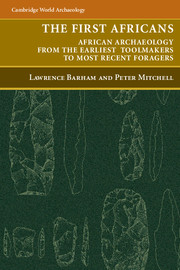Book contents
- Frontmatter
- Contents
- List of Figures and Tables
- Acknowledgements
- THE FIRST AFRICANS
- 1 Introducing the African Record
- 2 Frameworks in Space and Time
- 3 First Tool-Users and -Makers
- 4 Early Pleistocene Technologies and Societies
- 5 Mid-Pleistocene Foragers
- 6 Transitions and Origins
- 7 The Big Dry: The Archaeology of Marine Isotope Stages 4–2
- 8 Transitions: From the Pleistocene into the Holocene
- 9 Hunting, Gathering, Intensifying: The Mid-Holocene Record
- 10 Foragers in a World of Farmers
- 11 The Future of the First Africans' Past
- Notes
- Glossary
- References
- Index
6 - Transitions and Origins
Published online by Cambridge University Press: 05 June 2012
- Frontmatter
- Contents
- List of Figures and Tables
- Acknowledgements
- THE FIRST AFRICANS
- 1 Introducing the African Record
- 2 Frameworks in Space and Time
- 3 First Tool-Users and -Makers
- 4 Early Pleistocene Technologies and Societies
- 5 Mid-Pleistocene Foragers
- 6 Transitions and Origins
- 7 The Big Dry: The Archaeology of Marine Isotope Stages 4–2
- 8 Transitions: From the Pleistocene into the Holocene
- 9 Hunting, Gathering, Intensifying: The Mid-Holocene Record
- 10 Foragers in a World of Farmers
- 11 The Future of the First Africans' Past
- Notes
- Glossary
- References
- Index
Summary
The gradual establishment of the 100,000-year pattern of glacial cycles in the mid-Pleistocene created a long interval of instability in Africa's climate that posed new selective pressures for hominin societies. Integrated technological, social, neurological, and genetic changes effectively broadened the range of habitats in which Homo erectus and its descendants lived, with many of these developments taking place in response to the variability of mid-Pleistocene climates. The archaeological record in particular shows the application of technological solutions by H. erectus and, later, by Homo heidelbergensis to challenges of mobility linked to shifting resource distributions. These patterns of integrated behavioural and biological change provide a framework for assessing the impact of climate change on hominin evolution to the end of the mid-Pleistocene and through the start of the late Pleistocene (~430–70 kya, MIS 12-MIS 5a). This relatively short period encompasses significant changes in technology and other behaviours, as well as the evolution of the anatomically modern human form. The innovation of composite tool technologies (Mode 3) took place ~300 kya, and before the evolution of Homo sapiens ~200 kya, though for some a correspondence may exist between the appearance of Mode 3 and the evolution of Homo helmei, a putative ancestor of H. sapiens. Regardless of the species involved, Mode 3 makers developed the first distinctive regional artefact styles in the form of bifacial points, and the earliest archaeological indicators of symbolic expression.
- Type
- Chapter
- Information
- The First AfricansAfrican Archaeology from the Earliest Toolmakers to Most Recent Foragers, pp. 201 - 259Publisher: Cambridge University PressPrint publication year: 2008



